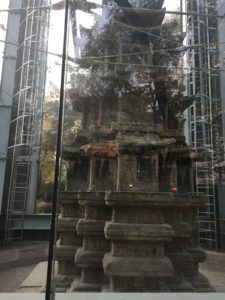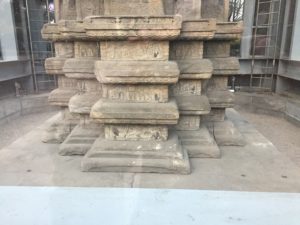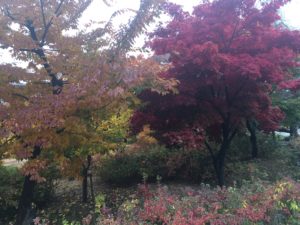Tuesday, 6 November 2018
A day on the subways. This was not the plan for the day, but that is what the day brought. I forgot the exiit or I got on the right train but it was the wrong direction or I misunderstood the Hangul or I misunderstood the directions given me by the Tourist personnel or I just got tired. Endless walking of endless stone corridors, endless steps, endless machines (Pepsi made it; Coke did not), endless ads, endless signs, endless shops offering things I thankfully do not need, endless food (probably not organic), more signs. Now here is a sign to the clean and much appreciated rest rooms. In the ladies room fine art work and a urinal. For the Transgender? And two potties, one for big people and one little people, side by side. More steps. Only the last set of steps was fun. When people walked on them, the steps lit up!
 And then the day was redeemed Now I knew the subways. (Boy, do I know the subways.) But now that I knew the subways, I was able to slip two stops away from the subway closest to my room to see the Tapgol Pagoda that Clarence Gamble saw and photographed in1908.
And then the day was redeemed Now I knew the subways. (Boy, do I know the subways.) But now that I knew the subways, I was able to slip two stops away from the subway closest to my room to see the Tapgol Pagoda that Clarence Gamble saw and photographed in1908.
This time an elevator (elevators are relatively rare within the subways, but the government does build them where people have to be moved up into the center of a tight street corner too small to accommodate large entry steps). Out of the elevator onto a busy busy commercial street replete with sirens, neon-lit signs and stores – and street vendors with wares spread out on blankets – even one food vendor (food NOT spread out on blanket). And at the end corner of this very commercial street a classic Korean wooden entry into a classic Korean park, well swept walkways, trees and bushes in their fall colors of yellow and burnt orange, and all quite peaceful. Behind a decorated wooden rotunda, completely encased in reinforced glass, stood the Tapgol pagoda, the very one Clarence saw. Difficult to photograph it through the glass, but here is the base and here it is today.
The Tapgol has a rich history. The ten tier pagoda, or the Wongaksa pagoda, was built of marble in 1467 became part of a Buddhist temple when the king was a devout Buddhist, but when the government changed and Buddhism was no longer the fashion, everything was destroyed except the pagoda. Around 1900, an Irishman, Brown McLeavy, persuaded King Gojong to create the first public park in Korea with the pagoda as its centerpiece.
In the twentieth century, the declaration that sparked the March First movement was read in the park. The resulting resistance against the Japanese military control brought many deaths and further repression. Today, it is a beautiful and restful place to visit, an oasis in the center of the commercial bustle of Jong-no and surrounding streets.






